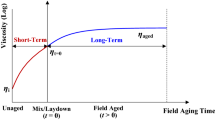Abstract
Oxidative aging of asphalt is a primary cause of binder hardening in pavements, thus contributing to various forms of pavement failures. An essential element of predicting long-term pavement performance is to understand binder oxidative aging and its effect on engineering properties. Five asphalt binders were evaluated relative to their changes in engineering and chemical properties in pavement service. Laboratory rolling thin-film oven test (RTFOT) and pressure aging vessel (PAV) test were conducted to simulate the in-situ pavement aging. In addition, a test road was constructed for this study to investigate the real aging process in the field. Comparable data were shown between field binders and laboratory binders aged at temperature 60°C under pressure 20 kg/cm2. The aging time of asphalts in PAV depended on how long pavements were used in the field. This paper was to determine the temperature and pressure used for PAV to simulate aging condition in the field. A good correlation between field-service and laboratory aging during test road project was found. An aging model was proposed to predict the changes in paving binder’s properties during field age hardening. Results were shown to give a close fit with experimental data from both laboratory and field aging tests. This model allowed highway engineers to quantify two essential characteristics of binder aging: the aging rate and the ultimate degree of changes in binder properties due to aging.
Résumé
Le vieillissement par oxydation de l’asphalte est la principale cause du durcissement des liants des chaussées. L’un des éléments essentiels permettant de prédire à long terme les performances d’une chaussée est de comprendre le système de vieillissement par oxydation et son effet sur les propriétés techniques. Cinq liants routiers hydrocarbonés ont été évalués selon leurs changements de propriétés techniques et chimiques.
Des essais en laboratoire de laminage à chaud en couche fine (Laboratory rolling thin-film oven test—RTFOT) ainsi qu’en container sous pression (Pressure aging vessel—PAV) ont été réalisés afin de simuler le comportement réel in situ de la chaussée. De plus, une route expérimentale a été construite pour ces études, afin d’examiner le processus de vieillissement sur le terrain.
Des données sur les liants ont été relevées sur le terrain ainsi qu’en laboratoire (température de 60°C, pression de 20 kg/cm2). La durée du vieillissement des asphaltes en PAV dépend de la durée d’utilisation sur le terrain. Cet article tente de déterminer la température et la pression utilisées en PAV de façon à simuler en laboratoire les conditions du processus de vieillissement sur le terrain. Une bonne corrélation a été établie entre les processus de vieillissement enregistrés sur le terrain et en laboratoire au cours des différents essais du projet. Un modèle du processus de vieillissement a donc été proposé de manière à pouvoir prédire les changements de propriétés des liants des chaussées durant le temps de durcissement sur le terrain. Les résultats ont confirmé l’existence de correspondances très proches entre les données expérimentales des essais de vieillissement en laboratoire et sur le terrain. Ce modèle permet aux ingénieurs d’évaluer deux caractéristiques essentielles du processus de vieillissement du liant: le taux du processus de vieillissement et le degré ultime des changements de propriétés des liants causés par le vieillissement.
Similar content being viewed by others
References
European Asphalt Pavement Association, Asphalt in Figures, (The Netherlands, Breukelen, 1998).
Lee, D.-Y., ‘Asphalt durability correlation in Iowa’,Highway Research Record 468 (1973) 43–60.
Mirza, M. W. and Witczak, M. W., ‘Development of a global aging system for short and long term aging of asphalt cements’,Journal of the Association of Asphalt Paving Technologists 64 (1995) 393–430.
Doucet, P. and Sloep, P. B., ‘Mathematical modeling in the life science’, 2nd Edn. (England, Chichester, 1992).
Liu, M., Lunsford, K. M., Davison, R. R., Glover, C. J. and Bullin, J. A., ‘The kinetics of carbonyl formation in asphalt’,AICHE Journal 42 (1996) 1069–1076.
Petersen, J. C., Branthaver, J. F., Robertson, R. E., Harnsberger, P. M., Duvall, J. J. and Ensley, E. K., ‘Effects of physicochemical factors on asphalt oxidation kinetic’,Transportation Research Record 1391 (1993) 1–10.
Martin, K. L., Davison, R. R., Glover, C. J. and Bullin, J. A., ‘Asphalt aging in Texas roads and test sections’,Transportation Research Record 1269 (1990) 9–18.
Petersen, J. C., ‘Quantitative functional group analysis of asphalts using differential Infrared spectrometry and selective chemical reactions—theory and applications’,Transportation Research Record 1096 (1986) 1–10.
Author information
Authors and Affiliations
Rights and permissions
About this article
Cite this article
Chen, J.S., Huang, L.S. Developing an aging model to evaluate engineering properties of asphalt paving binders. Mat. Struct. 33, 559–565 (2000). https://doi.org/10.1007/BF02480536
Received:
Accepted:
Issue Date:
DOI: https://doi.org/10.1007/BF02480536




